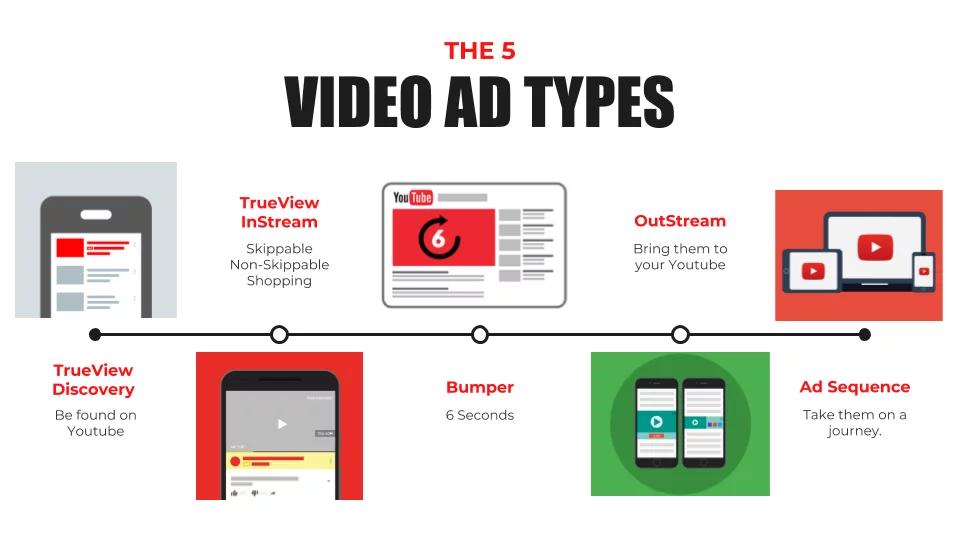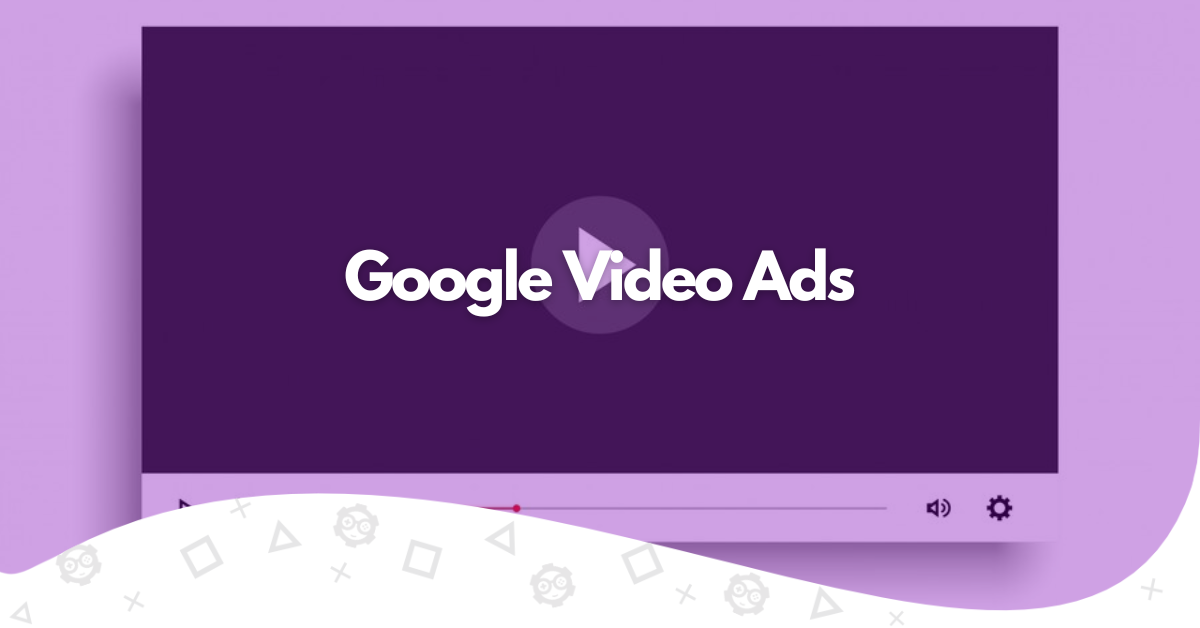In the ever-evolving landscape of online advertising, Google Video ads have emerged as a powerhouse, revolutionizing the way businesses connect with their audiences. From YouTube videos to video campaigns across various platforms, the potential for reaching and engaging potential customers is vast. In this comprehensive guide, we’ll navigate the intricacies of Google Video Ads, exploring key features, ad formats, targeting techniques, and optimization strategies to ensure your campaigns stand out in the digital crowd.
Whether you’re a seasoned advertiser or just stepping into the realm of video advertising, this guide will equip you with the knowledge needed to create compelling Video Ad campaigns on Google’s expansive network. Let’s embark on a journey to unlock the full potential of Google Video Ads and elevate your digital marketing efforts.
What Are Google Video Ads?

Google Video Ads represent a dynamic and influential facet of online advertising, allowing businesses to showcase their products, services, or messages through engaging video content. Leveraging the extensive reach of Google’s advertising network, these ads are strategically positioned across various platforms, with YouTube being a primary and powerful avenue.
Key Components of Google Video Ads
Ad Formats: Google Video Ads come across various formats, including skippable in-stream ads, bumper ads, and non-skippable in-stream ads. Each format offers unique advantages, catering to different campaign goals and audience preferences.
Ad Groups and T targeting: Advertisers can organize their campaigns into Ad Groups, each with specific targeting parameters. This includes demographics, interests, and even placement on YouTube channels or videos.
Ad Sequences and Masthead Ads: Advertisers can create sequences of ads to tell a compelling story and increase viewer engagement. Masthead Ads, prominently displayed at the top of YouTube’s home feed, offer unparalleled visibility.
Ad Scheduling and Bid Strategies: Fine-tune ad campaigns with precise scheduling and bidding strategies. Whether maximizing clicks, targeting CPA, or focusing on brand awareness. Google Video Ads provide flexibility to align with diverse marketing objectives.
Ad URLs and Landing Pages: Drive traffic to specific URLs, utilizing various options such as click ad URL, landing page URL, and tracking templates. This ensures that users are directed to relevant content or products seamlessly.
Companion Banners and Display URLs: Enhance the visual appeal of ads with companion banners and provide additional information through display URLs. This boosts brand visibility and aids in creating a cohesive and immersive ad experience.
Types of Google Video Ads

Google Video Ads come in diverse formats, each designed to cater to specific campaign objectives and audience preferences. Video Ads is one of many types of Google Ads. Understanding the nuances of each type of video ads empowers advertisers to create engaging content tailored to their marketing goals.
Skippable In-Stream Ads: These ads play before, during, or after YouTube videos and allow viewers to skip after the initial five seconds. Advertisers only pay when viewers watch beyond this mandatory period, making it an effective format for capturing attention quickly.
Bumper Ads: Brevity is key with short bumper ads and non-skippable ads lasting six seconds or less. Ideal for delivering concise messages, these ads are particularly effective for brand awareness and maintaining viewer attention in a world where time is precious.
Non-Skippable In-Stream Ads: As the name suggests, viewers cannot skip these ads, offering advertisers an uninterrupted platform to convey their message. While limited to 15 seconds, this format ensures maximum exposure and engagement during the entire duration.
Outstream Ads: These ads go beyond the confines of YouTube, appearing on partner sites and apps within the Google Display Network. Designed for mobile viewing, Outstream Ads automatically play without sound and pause when out of view, conserving user experience.
Masthead Ads: Positioned prominently at the top of YouTube’s home feed, Masthead Ads provide advertisers with unparalleled visibility. These ads are typically booked on a reservation basis, ensuring they are exclusive to a vast audience.
Video Discovery Ads: These ads appear in YouTube search results, alongside related videos, and on the YouTube homepage. Video discovery ads invite engagement by enticing users to click and watch, making them an effective choice for promoting content.
Ad Sequences: Advertisers can tell a comprehensive story by creating sequences of ads. This format allows for a series of videos to be shown to viewers in a specific order, optimizing narrative flow and user engagement.
In-Stream Ads on Google Video Partners: Extend your reach beyond Youtube by displaying In-Stream Ads on Google Video Partners, expanding visibility across a network of websites and apps.
Understanding the strengths and applications of each Google Video Ad type is crucial for crafting campaigns that resonate with your target audience.
Benefits of Google Video Ads

Video advertising has become a cornerstone of digital marketing. Google Video Ads, in particular, offer many advantages for businesses aiming to elevate their online presence and engage with their target audience effectively.
Enhanced Engagement: Video content is inherently captivating, providing a multisensory experience that resonates strongly with viewers. Google Video Ads leverage this medium to capture attention and create a lasting impression, fostering deeper engagement with the audience.
Increased Brand Visibility: With the vast reach of Google’s advertising network, Video Ads enable brands to showcase their products or messages to a global audience. Businesses can significantly boost brand visibility and recognition through YouTube, partner sites, or mobile apps.
Versatile Ad Formats: Google Video Ads offer a range of formats, from skippable and non-skippable in-stream ads to bumper ads and masthead ads. This versatility allows advertisers to tailor their campaigns to specific goals, ensuring maximum impact and relevance.
Targeted Advertising: Utilizing detailed targeting options, advertisers can narrow down their audience based on demographics, interests, and online behavior. This precision targeting ensures that Video Ads reach the most relevant audience, increasing the likelihood of conversions.
Storytelling Opportunities: Video Ads provide a powerful platform for storytelling. Advertisers can craft narratives, showcase product features, and convey brand messages compellingly and immersively, fostering a stronger connection with viewers.
Comprehensive Analytics: Google’s robust analytics provide in-depth insights into the performance of Video Ads. Advertisers can track metrics such as views, click-through rates, and audience demographics, allowing for data-driven optimization and strategic decision-making.
Mobile Optimization: As mobile usage continues to surge, Google Video Ads are optimized for mobile devices, ensuring seamless viewing experiences. This adaptability enhances accessibility and allows advertisers to effectively tap into the growing mobile user base.
Flexibility in Ad Duration: Whether choosing brief bumper ads or longer in-stream formats, advertisers can tailor the duration of their video content to suit campaign objectives. This adaptability caters to varying audience preferences and content requirements.
Measurable ROI: With precise tracking and analytics, advertisers can measure the return on investment (ROI) of their video campaigns. This data-driven approach enables continuous refinement, effectively allocating marketing budgets.
Call-to-Action Integration: Google Video Ads allow seamless integration of call-to-action elements, prompting viewers to take immediate actions such as visiting a website, purchasing, or engaging with additional content.
By harnessing the benefits of Google Video Ads, businesses can create impactful, targeted campaigns that boost brand awareness and drive meaningful interactions with their audience, ultimately contributing to overall marketing success.
Steps to Creating a Google Ads Video Campaign

Launching a successful Google Ads Video Campaign requires a systematic approach encompassing planning, content creation, and strategic optimization.
Follow these steps to ensure your video campaigns on Google Ads are compelling and effective in achieving your marketing goals.
Define Your Campaign Objectives: Clearly outline your goals. Whether driving website traffic, increasing brand awareness, or generating leads, a well-defined objective is the foundation for your entire video campaign.
Access Your Google Ads Account: Log in to your Google Ads account. If you don’t have one, create an account and navigate to the Campaigns tab to initiate the campaign creation process.
Select Campaign Type: Choose “Video” as your campaign type. This selection ensures that your campaign is optimized for video content and aligns with your goals.
Choose Campaign Subtype: Opt for the subtype that best suits your objectives. Options include “Product and Brand Consideration”, “Brand Awareness and Reach,”; and “Drive Conversions.”
Set Your Campaign Settings: Define your campaign settings, including the campaign name, budget, and bidding strategy. Choose between daily or campaign total budget and select a bidding strategy aligned with your campaign goals, whether maximizing clicks or targeting a specific cost per acquisition (CPA).
Define Ad Group Details: Create ad groups within your campaign. Organize your video ads based on shared themes or target audiences. This segmentation allows for more precise targeting and measurement of ad performance.
Create Your Video Ad: Upload your video content or link to your YouTube video. Craft a compelling headline and description, and choose an engaging thumbnail to entice viewers. Ensure your video aligns with the ad format selected for your campaign.
Ad Group Targeting: Specify the audience for each ad group. Utilize demographics, interests, and behaviors to narrow down your target audience. Consider factors such as age, gender, interests, and geographical location.
Set Bid Amounts: Establish bid amounts for your ad groups. Bid strategically based on your campaign objectives, whether it’s maximizing views, clicks, or conversions. Google Ads provides options such as maximum CPV (Cost Per View) or target CPA bidding.
Choose Placements: Determine where your ads will appear. Select placements on YouTube, Google Video Partners, or the Display Network. Tailor your selection based on where your target audience will most likely engage with your content.
Ad Schedule: Set the schedule for when your ads will run. Define specific days and times to maximize visibility when your target audience is most active.
Create Companion Banners and Display URLs: Enhance your video ads with companion banners and provide additional information through display URLs. This adds visual appeal and supports your overall branding strategy.
Review and Launch: Carefully review all settings, targeting options, and ad creatives. Once satisfied, click the “Launch” button to set your Google Ads Video Campaign live.
Monitor and Optimize: Regularly monitor the performance of your video campaign using Google Ads analytics. Adjust bidding strategies, refine targeting, and optimize ad creatives based on the insights gained to maximize the effectiveness of your campaign.
By following these steps, you can create a Google Ads Video Campaign that aligns with your marketing objectives and resonates with your target audience, driving meaningful engagement and results.
Strategic Planning for a New Video Campaign

Launching a successful video campaign requires careful planning and a strategic approach from the initial concept to the launch. We’ll explore the key steps and considerations for developing and executing a video campaign that captures attention and achieves your brand’s objectives.
Defining Clear Objectives
Begin by clearly outlining the objectives of your video campaign. Defining specific and measurable goals sets the foundation for a successful campaign, whether it’s to increase brand awareness, drive conversions, or promote a new product.
Understanding Your Target Audience
Conduct thorough audience research to understand your target audience’s demographics, interests, and behaviors. This information will shape the content and messaging of your video to resonate effectively.
Crafting a Compelling Story
Develop a narrative that showcases your brand and resonates emotionally with your audience. A compelling story is key to capturing and maintaining viewer attention throughout your campaign.
Selecting the Right Platforms
Identify the platforms that align with your campaign goals and audience preferences. Whether it’s a YouTube channel, social media platforms, or other video partners, choosing the right platforms maximizes the reach and impact of your campaign.
Choosing an Eligible Ad Format
Explore the eligible ad formats available on the selected platforms. Consider options like skippable in-stream ads, bumper ads, or out-stream ads based on the campaign’s goals and the viewing behavior of your target audience.
Setting a Daily Budget
Establish a realistic daily budget for your campaign. Consider factors such as your overall budget, campaign duration, and cost-per-view (CPV) to ensure efficient allocation of resources.
Determining Full Duration and Goal’s Guidance
Define the full duration of your video ad content, considering the platform requirements and viewer preferences. Align the duration with the guidance of your campaign goals, whether it’s building brand awareness or driving immediate conversions.
Tailoring for Demographic Groups
Customize your video content to resonate with specific demographic groups with your target audience. Consider age, gender, location, and interests to create content that speaks directly to your viewers.
Considering Household Income and Parental Status
If relevant, consider household income and parental status when tailoring your content. Understanding these demographics allows for nuanced messaging that connects with different audience segments.
Setting Preferred Language
Choose the preferred language for your video content based on your target audience. Ensuring your message is communicated in the language your viewers are most comfortable with enhances overall engagement.
Defining an Engaging Call-to-Action (CTA)
Craft a clear and compelling call-to-action (CTA) that guides viewers to the desired action. Whether visiting a website, subscribing, or purchasing, the CTA should align with your campaign objectives.
Choosing a Bid Strategy
Select an appropriate bid strategy that aligns with your campaign goals. Whether maximizing clicks, reaching a specific audience, or optimizing for conversions, the bid strategy shapes how your campaign budget is spent.
Collaborating with a Google Representative
Consider seeking guidance from a Google representative. Their expertise can provide valuable insights, optimize your campaign settings, and ensure you make the most of available features for a successful launch.
Leveraging YouTube URL Optimization
Optimize your video campaign further by strategically leveraging video URL options. This includes customizing display URLs to direct viewers to specific pages, ensuring a seamless transition from watching your ad to engaging with your brand.
Setting an Ad Schedule and End Date
Define an ad schedule that aligns with peak viewing times for your target audience. Additionally, set a clear end date for your campaign, allowing you to measure performance and adjust strategies as needed.
Maximizing Click Ad URL Options
Explore the various click ad URL options available and how they can be strategically employed to guide viewers to specific landing pages, maximizing engagement and conversions.
Utilizing TV Screens for Brand Storytelling
Leverage the unique attributes of TV screens for immersive brand storytelling. Explore how the larger screen size and lean-back viewing experience can be harnessed to convey a compelling narrative that resonates with your audience.
Utilizing Expert Mode for Advanced Settings
Explore the advanced settings in expert mode for additional customization. This may include fine-tuning targeting options, adjusting bid settings, and optimizing other parameters for a more tailored campaign.
Uploading and Editing Stream Ads
If applicable, manually upload and edit stream ads to ensure they align with your campaign goals and platform requirements. This step involves careful consideration of video content, thumbnails, and other visual elements.
By following these strategic steps from concept to launch, you’ll position your video campaign for success. This comprehensive approach ensures that every aspect of your campaign, from content creation to platform selection and optimization, is aligned with your overarching goals.
Conclusion
In summary, orchestrating a successful video campaign involves strategic planning with elements like YouTube Watch, companion banners, and ad sequences. Utilizing lead form extensions, tracking templates, and automatically generated URLs enhances audience engagement and aligns with brand awareness goals. With the ability to pay based on engagement through CPV bidding, advertisers can maximize clicks and guide people to their site, ensuring effective interaction on desktop and mobile platforms.
By strategically incorporating keywords, advertisers can appear prominently, make informed decisions, and achieve their campaign objectives seamlessly. Embracing these practices empowers advertisers to create compelling campaigns that resonate, captivate, and drive meaningful conversions.
Read also articles about other types Google Ads – What are Google Display Ads, Shopping Ads, Dynamic Search Ads, Discovery Ads, Performance Max campaign.

A PPC specialist who started with organic social media. For several years, the core of his activities are:- Google Ads, Microsoft Ads, Meta Ads, TikTok Ads, Twitter Ads, Linkedin Ads. He has led campaigns with a global reach, e.g. for FootballTeam, G2A, ETOTO, as well as many smaller campaigns in the sports, construction and financial industries. Has full focus on ROAS. Privately, a fan of football, history of wars and Star Wars.

